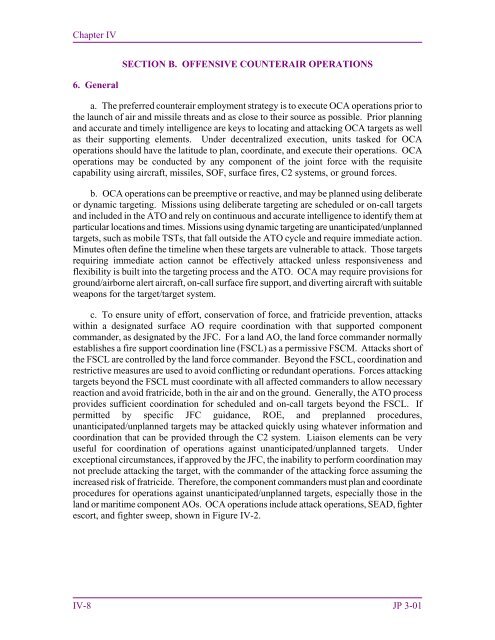JP 3-01 Countering Air and Missile Threats - Defense Innovation ...
JP 3-01 Countering Air and Missile Threats - Defense Innovation ...
JP 3-01 Countering Air and Missile Threats - Defense Innovation ...
You also want an ePaper? Increase the reach of your titles
YUMPU automatically turns print PDFs into web optimized ePapers that Google loves.
Chapter IV<br />
SECTION B. OFFENSIVE COUNTERAIR OPERATIONS<br />
6. General<br />
a. The preferred counterair employment strategy is to execute OCA operations prior to<br />
the launch of air <strong>and</strong> missile threats <strong>and</strong> as close to their source as possible. Prior planning<br />
<strong>and</strong> accurate <strong>and</strong> timely intelligence are keys to locating <strong>and</strong> attacking OCA targets as well<br />
as their supporting elements. Under decentralized execution, units tasked for OCA<br />
operations should have the latitude to plan, coordinate, <strong>and</strong> execute their operations. OCA<br />
operations may be conducted by any component of the joint force with the requisite<br />
capability using aircraft, missiles, SOF, surface fires, C2 systems, or ground forces.<br />
b. OCA operations can be preemptive or reactive, <strong>and</strong> may be planned using deliberate<br />
or dynamic targeting. Missions using deliberate targeting are scheduled or on-call targets<br />
<strong>and</strong> included in the ATO <strong>and</strong> rely on continuous <strong>and</strong> accurate intelligence to identify them at<br />
particular locations <strong>and</strong> times. Missions using dynamic targeting are unanticipated/unplanned<br />
targets, such as mobile TSTs, that fall outside the ATO cycle <strong>and</strong> require immediate action.<br />
Minutes often define the timeline when these targets are vulnerable to attack. Those targets<br />
requiring immediate action cannot be effectively attacked unless responsiveness <strong>and</strong><br />
flexibility is built into the targeting process <strong>and</strong> the ATO. OCA may require provisions for<br />
ground/airborne alert aircraft, on-call surface fire support, <strong>and</strong> diverting aircraft with suitable<br />
weapons for the target/target system.<br />
c. To ensure unity of effort, conservation of force, <strong>and</strong> fratricide prevention, attacks<br />
within a designated surface AO require coordination with that supported component<br />
comm<strong>and</strong>er, as designated by the JFC. For a l<strong>and</strong> AO, the l<strong>and</strong> force comm<strong>and</strong>er normally<br />
establishes a fire support coordination line (FSCL) as a permissive FSCM. Attacks short of<br />
the FSCL are controlled by the l<strong>and</strong> force comm<strong>and</strong>er. Beyond the FSCL, coordination <strong>and</strong><br />
restrictive measures are used to avoid conflicting or redundant operations. Forces attacking<br />
targets beyond the FSCL must coordinate with all affected comm<strong>and</strong>ers to allow necessary<br />
reaction <strong>and</strong> avoid fratricide, both in the air <strong>and</strong> on the ground. Generally, the ATO process<br />
provides sufficient coordination for scheduled <strong>and</strong> on-call targets beyond the FSCL. If<br />
permitted by specific JFC guidance, ROE, <strong>and</strong> preplanned procedures,<br />
unanticipated/unplanned targets may be attacked quickly using whatever information <strong>and</strong><br />
coordination that can be provided through the C2 system. Liaison elements can be very<br />
useful for coordination of operations against unanticipated/unplanned targets. Under<br />
exceptional circumstances, if approved by the JFC, the inability to perform coordination may<br />
not preclude attacking the target, with the comm<strong>and</strong>er of the attacking force assuming the<br />
increased risk of fratricide. Therefore, the component comm<strong>and</strong>ers must plan <strong>and</strong> coordinate<br />
procedures for operations against unanticipated/unplanned targets, especially those in the<br />
l<strong>and</strong> or maritime component AOs. OCA operations include attack operations, SEAD, fighter<br />
escort, <strong>and</strong> fighter sweep, shown in Figure IV-2.<br />
IV-8 <strong>JP</strong> 3-<strong>01</strong>

















